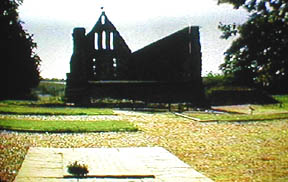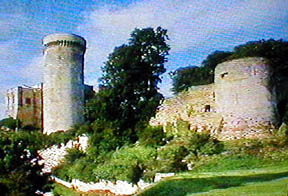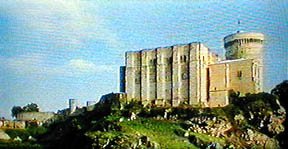
|
 Below is given a list of companions who
supposedly accompanied William the Bastard of Falaise, Duke
of Normandy, [later William I of England] at the Battle of Hastings.
For their services, each commander was granted lordship of large
areas of English countryside, albeit each being widely separated
from the other. To the victors went the spoils.
Below is given a list of companions who
supposedly accompanied William the Bastard of Falaise, Duke
of Normandy, [later William I of England] at the Battle of Hastings.
For their services, each commander was granted lordship of large
areas of English countryside, albeit each being widely separated
from the other. To the victors went the spoils. 
|
| 'Senlac' or 'the field of blood' - recreation of the 'Battle of Hastings' at Battle, 2006. |
|
|
A

|

|

|
|
The name of King William in the Domesday Book 1086 |
Battle Abbey Church built
under the orders of William the Conqueror. Foreground:
traditional site where Harold Godwinsone fell, which became the altar for the first Battle Abbey. Senlac the
'blood-lake' or battlefield. Note the remains of the three light window. |
Text from the Domesday Book |
BATTLE ABBEY WINDOW PRESERVED?
There is a claim that a partly restored Battle Abbey three light window was sent to Tasmania in the mid 1800's. By contrast, today the remains of Battle Abbey do not possess any stained glass windows.
By the Revd. H.M. Maddock, Th.L.
Considerable controversy has arisen with reference to the age and origin of the very beautiful East Window of St. John the Baptist [In Buckland Church, Tasmania!] The only authentic reference to the origin of the window is a report in the 'Hobart Town Crier' of Wednesday 15th January 1850, which clams they are 'the work of Mr. O' Connor, a London artist'. The East Window is of such outstanding quality that several legendary stories are current with regard to its origin, the salient points of which are that it was buried for safety during the Cromwellian Rebellion., that it was connected with a church built by William the Conqueror, and that it was sent out to Tasmania through the agency of the first rector of Buckland, the Revd. F. H. Cox; unfortunately the one person who could have solved the riddle of its origin chose to maintain a strict silence with regard to it. In some respects this was typical of Mr. Cox, whose reticent nature led him to maintain a similar secrecy with regard to the origin of many valuable gifts for which he was personally responsible.
An examination of the window itself makes it possible to determine its approximate date as between 1350 and 1400. To commence, we know for certain that the window was 'in situ' at Buckland between 1848 and 1850, which disposes of the possibility of it being a modern reproduction of an antique, because the art of reproducing antiques did not come into practice until a much later date. A superficial examination discloses that the window has been extensively restored at some period, many quarries (individual panes of glass) being obviously different in colour to the original, and where the restored quarries bear handwork in enamel, the workmanship is markedly inferior to that of the original.
The style of the window is known technically as 'White Grisaille', which was a style of treatment peculiar to the English School of Glass Painters, and reached its greatest development in the 14th century. The white background of the English Grisaille contrasts markedly with the Continental work of the same period, where the background was mainly done in reds and blues, producing a purple effect peculiar to Continental churches.
The earliest date that can be attributed to the window is the middle of the 14th century, because it contains a quantity of 'Silver-yellow stain', no known examples, of which occur before 1350. Similarly the latest reasonable date is early in the 15th century, by reason of the fact that this century was marked by the introduction and development of the architectural canopy treatment, which is so familiar a feature of modern painted glass. This architectural canopy is absent from the Buckland window, though the central ight has a canopy treatment which may suggest the trend towards the development of the architectural motif.
Finally, 'English Stained Glass' by Herbert Read, a standard work on the subject, gives (fig. 3, page 31) as a typical example of English White Grisaille, an illustration of a window in Merton College, Oxford, definitely dated as 'Early 14th century'. The similarity between the treatment of the grisaille of the Oxford window and that of Buckland is arresting.
From internal evidence we may reasonably conclude that the Buckland window belongs to the latter half of the 14th century, 1350-1400, and that it is of English workmanship.
Legend links the window with William the Conqueror. William I was responsible for the building of but one church in England, Battle Abbey, the site of the Battle of Hastings, in Sussex. The church was particularly selected by Cromwell's soldiers for destruction, its ruins being an English National monument today. The Cecil family was closely connected with the district. Lord Robert Cecil, third Marquis of Salisbury, Secretary of State for the Colonies, was a personal friend of Dean Cox, and is credited with with having sent the window to his friend at Buckland. It should also be noted that Dean Cox himself came from Sussex.
We may reasonably assume then that the window was once connected with the Cecil family, placed in Battle Abbey, that it was removed for safety, and buried during the Cromwellian Rebellion. Battle Abbey was never restored, and some 200,yeaers after its removal from its original setting the glass was sent to Tasmania. If this reconstruction is correct, it would supply sufficient reason for the otherwise mysterious secrecy with regard to its origin.
Again we have a statement of the reporter of the 'Hobart Town Courier' of January 1850, who stated that the windows, 'A large eastern window of three lights and a smaller one of two lights on the north side......,are the work of Mr. O'Connor, a London artist'. A closer comparison of the two windows reveals that 'the smaller one of two lights' is of distinctly inferior workmanship to that of the east window, and a careful comparison reveals a marked similarity of workmanship between this window and the restored portions of the East window, which suggests the explanation that the East window was entrusted to Mr. O' Connor for restoration, and that he was commissioned to execute the smaller window in the same style and to dispatch both windows to Buckland. This may easily have led tpo the association of his name with both windows in the newspaper report.
 |
| The restored three light window in the church of St. John the Baptist, Buckland, Tasmania, parts of which are reputed to have come from Battle Abbey. |
Revd. R.N. Fox: As the result of the examination of the condition of the window, it was decided that an expert be called in to give an opinion. The result was that the window was removed, sent by air to Sydney for re-leading and cleaning. Mr. P. Barnard of Standard Glass Studios who carried out the work reported as follows:
14th December 1960- 'An Opinion: the window has most probably been re-leaded at least four times (including the present year - 1960). Much of the patterned background is mid 19th century work having been copied from older painted glass which during burial, was damaged, and discarded as useless. I think this because practically all the present background glass is much too thin to be genuinely medieval. It may be that O'Connor thought that 19th century glass of his making was superior to the older stuff! B Fact: the actual figure work is, undoubtedly, the genuine 14th century work; and after all it is the figures that are so important in the window, not borders and ornament.'
B

|

|

|
|
Falaise Castle, Normandy |
Dover Castle, England |
Falaise Castle, birthplace of William
I of England, Duke of Normandy |

|

|

|
|
Peveril Castle Keep reconstructed |
Rochester Castle Keep
reconstructed |
Orford Castle
Keep |

|
|

|
|
London Castle Gateway |
The keep or White Tower, London
Castle |

Rochester Castle, Kent |
 Roger? de Muscamp
[Muschamp]. Held Willoughby, Lincolnshire. The
Muschamps of Lincolnshire were stewards to Gilbert
de Gand .
Roger? de Muscamp
[Muschamp]. Held Willoughby, Lincolnshire. The
Muschamps of Lincolnshire were stewards to Gilbert
de Gand .
|

|

|

William I of England and Duke of Normandy |
|
Statue of William I of England,
Falaise |

William's wife's name on her grave-cover, Normandy. |
1. The son of Roger de Muscamp who held Wilgebi
(Willoughby) in Lincoln in 10863.
2. The National Archives. Record #1, Domesday
Book.
3. Duchesne, Andre, Historiae Normannorum,
1619. "Battle Abbey Roll"
4. The Conqueror and
his Companions - an excellent link site
5. Sources from the Bayeaux tapestry, Orderic
the Monk & the Historian, William of Potiers.
6. Email contact from Stephen Pinkerton; Domesday
Book for Yorkshire. Part 2,
Phillimore, Domesday tenants.
7. Who
really accompanied the Conqueror?
8. Powlett, L.W. Battle Abbey Roll with some account of the Norman lineages ii 1889.
9. Ibid ii
10. Ibid.
i